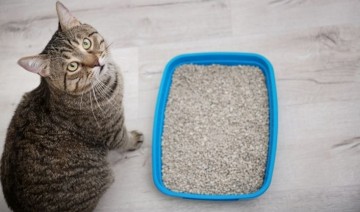{article.name}
Non-Health Reasons Your Cat Has Stopped Using the Litter Box

- Share this:
- Share on Facebook
- Pin on Pinterest
- Tweet on Twitter
Cats are notorious for their finicky preferences, but they can also be creatures of predictable habits. How a cat uses its litter box is often one of those predictable habits, and knowing why your cat has stopped using the litter box can help you better understand your pet’s behavior, needs, and preferences.
Rule Out Health Reasons
There are many health-related reasons why a cat may stop using its litter box. Because different conditions from simple urinary tract infections or arthritis to more serious diseases such as diabetes, bladder stones, feline interstitial cystitis, and different cancers can change a cat’s litter box habits, it is important to consult a veterinarian right away if your cat’s potty habits change. This will rule out any medical issues or identify a course of treatment if necessary before your cat’s health deteriorates dangerously.
Other Reasons Why Cats Refuse a Litter Box
There are many non-health reasons why a cat may stop using a litter box. If your pet’s health isn’t the cause of litter box behavior, consider these other factors and which ones may be causing difficulties.
- Not Enough Litter Boxes
Some cats prefer to urinate in one box and defecate in another. If only one litter box is available, the cat may turn to potted plants, carpeting, or quiet corners to do its business. Similarly, some cats prefer not to share litter boxes, so if you have more than one cat, you should have more than one litter box so every animal has its own private space.
- Uncomfortable Litter
A cat’s paws are very sensitive, and litter that doesn’t feel right can make the cat avoid the litter box. This could be because of the litter’s size or texture, especially if you have recently switched litter brands. A heavily scented litter may also be too strong for a cat’s nose and could cause it to move its bathroom business elsewhere.
- Improper Box Size
A litter box should be large enough for the cat to comfortably turn and scratch while still feeling as if it can escape if threatened. Litter boxes that were a great size for a kitten may be too small for an adult cat, or a litter box in a tight corner or confined space may make the cat feel too enclosed to use the box appropriately.
- Lack of Privacy
Cats will not feel comfortable using a litter box in a noisy, high traffic area or very public space in the home. Cats feel vulnerable when eliminating, and the box should be in a somewhat sheltered, private area where they feel secure but not so enclosed that they may feel trapped or intimidated.
- Dirty Box
A dirty litter box can be off-putting for a cat, and they may stop using a box if it is not cleaned and refreshed regularly. This is especially true if multiple cats are using the box and it will collect odors much more quickly.
- Household Changes
Different disruptions to a cat’s daily routine can affect its litter box habits because of anxiety or stress. Adding a new pet to the home, moving, renovations, changing mealtimes, or even just rearranging furniture could disrupt a cat enough to change its litter box use.
Making the Litter Box Cat-Friendly
Regardless of why a cat may stop using its litter box, there are simple tricks to help make the box more appealing and avoid unwanted accidents in other parts of your home. To help your cat feel comfortable using the litter box…
- Choose a box that is the right size for the cat. Avoid styles with covers that can seem too confining, and be sure the sides are low enough for the cat to enter easily.
- Have multiple litter boxes available in different areas that will be safe and comfortable for your cat to visit. If the box has to be moved, do so slowly so the cat can more easily switch places.
- Position the litter box or boxes away from the cat’s food and water bowls. Most cats will not eliminate near where they eat or drink. A quiet, semi-private space is best.
- Use the cat’s preferred litter or other litter box material, ideally choosing a clumping, unscented style. If you must switch litters, do so gradually so the cat can adjust to the change.
- Avoid using large litter box liners. Plastic liners can crinkle and make a lot of noise that could spook a cat. If necessary, use a sheet or two of newspaper on the bottom of the box.
- Keep litter just 1-2 inches deep. Cats need enough depth to scratch at the litter, but very deep litter can be uncomfortable and may discourage the cat from using it.
- Clean the box often and thoroughly. This may mean scooping the litter multiple times each day, and completely scrubbing the box and replacing all the litter each week.
- Clean up any out-of-box accidents quickly and thoroughly, using enzymatic cleaners to neutralize odors so cats are less likely to consider the spot appropriate for bathroom use.
- Take steps to lower household stress and reduce the cat’s anxiety to ease its bathroom habits. A nervous cat is more likely to have accidents or change its litter box habits.
There may be many reasons why your cat has stopped using the litter box. By making the box as comfortable and stress-free as possible, you can discourage any non-box elimination and keep your cat happy without extra cleanups or behavioral problems.

Comments